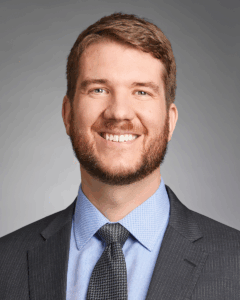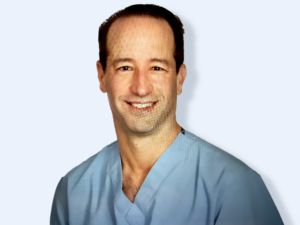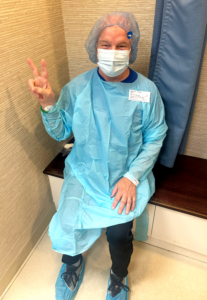
June is Cataract Awareness Month, a time to protect your vision. Early detection and treatment can maintain and even improve your quality of life.
Board-certified ophthalmologist George Wandling, MD, performs hundreds of cataract surgeries annually at the North Metro Surgery Center in Blaine, Minnesota.
“Talk with your optometrist or ophthalmologist about seeing better!” he said. “Cataract surgery is an amazing procedure with millions of happy experiences every year.”
Dr. Wandling recently shared his knowledge about cataracts, the importance of treatment and the benefits of choosing an ambulatory surgery center (ASC) for cataract procedures.
Q. What are cataracts, and why do they happen?
A. Cataracts are a hardening, yellowing and opacification of your natural crystalline lens in your eye. They happen to everyone in time. Sometimes medications, trauma or medical conditions make cataracts happen earlier. Cataracts are live cells, meaning they continue to grow and divide. Eventually, they become too clouded or hardened over the course of our life. Nowadays, the average age for people needing cataract intervention is about 70, because the vision has been affected to such a level that the patient is bothered.
Q. What are some of the most common signs or symptoms of cataracts that people should watch for?
A. Usually, the first thing people notice is nighttime driving symptoms, such as halos or glare around light, or the general diminishing of their vision at night.
It’s time to have surgery when we are no longer able to fix bothersome symptoms from cataracts by changing your glasses prescription. At that point, glasses can’t help any longer, and we have to take the cataract out and put in a new lens.
Q. How do cataracts impact daily life if left untreated?
A. If untreated, cataracts can make us completely blind. They can wholly opacify and turn into a white cataract. Most people have seen a dog with a white cataract where you look at their eye and see that it’s completely white centrally. At that point, color and objects can’t be seen; nothing other than light can be seen. Usually, patients pursue treatment well before they get to that point.
Q. At what point should someone consider seeing an eye doctor about their vision changes?
A. If you feel like your vision is affecting your daily life, you should see an eye doctor. Whether that be driving, seeing the crawl on the TV screen or seeing your grandkid’s baseball game.
Q. Is cataract surgery the only treatment option, or are there alternatives?
A. Typically, our first step is to try the patient in glasses or contacts. If that is insufficient and we determine that cataracts are the source of vision changes and are worsening, then we need to perform cataract surgery. There are no eye drops, homeopathic remedies or exercises that can reduce cataracts.
Q. What would you say to patients who are hesitant or anxious about cataract surgery?
A. Cataract surgery is as straightforward and non-invasive as surgeries come. We are confident that we can get anyone through cataract surgery. We have anesthesia in most cases to help the patient with any anxiety they may have. The success rate of cataract surgery is phenomenal, and the complication rate is very low.
Q. How has cataract surgery evolved in recent years, especially with the use of laser-assisted technology?
A. Cataract surgery in its current form started about 40 years ago. Laser-assisted technology started about 15 years ago. The laser has really helped us with precision and fixing astigmatism, which has held people back from obtaining their best possible vision. The laser has really helped us to get people out of glasses and made more complicated surgeries easier.
Further, over the past few years, the biggest evolution has been the variety of different lenses (trifocal, light adjustable lens, etc.). The depth of focus and the ability to be glasses-free after cataract surgery continues to evolve and is available for more and more patients with any eye health and with many different conditions.
Q. Can you explain the different lenses and how the right lens is chosen for each patient?
A. There are many different types of lens implants. There are standard lens implants that serve patients very well; however, the patient may need to be in contacts or glasses after the procedure.
Within the last five or six years, the variety of different lenses has grown.
There are monofocal lenses that give a little more arm’s length vision, but you’re still expected to need readers for fine print.
Multifocal lenses or trifocal lenses give great distance, intermediate and up-close vision. Many patients who choose these lenses are able to get out of glasses entirely.
There’s something called a light adjustable lens (LAL) that gives you contiguous vision and a lot of depth of field, and often, those patients are able to be glasses free as well.
The correct choice is ultimately up to the patient and a discussion with the patient’s ophthalmologist as to which may be the best option. Sometimes different lens implants have costs associated, as often insurance doesn’t cover all lens options.
NOTE: Patients should consult with their healthcare provider about coverage.
Q. What are the benefits of having cataract surgery at an Ambulatory Surgery Center (ASC) rather than a hospital?
A. ASCs have shown to be better than hospitals when it comes to patient experience, and the overall time in the facility is less at an ASC. Additionally, patients have lower complication rates, the staff are specialized and are very familiar with cataract procedures, and the recovery time is faster at ASCs.
Q. How do ASCs support a more comfortable or convenient experience for patients?
A. Because outpatient surgery is the sole purpose, it is easier for ASCs to make each patient feel valued. We are able to give the proper attention to the patient, and each staff member is empowered to help and well-versed with all of the procedures that come through our ASCs.
Q. What does a typical cataract procedure look like — from arrival to discharge?
A. The patient checks in at the front desk with a family member or friend and waits to be called back into the pre-operative area. Once they are called back to pre-op, the nursing team preps the patient for the procedure. The patient will get eye drops instilled and an IV so anesthesia can be delivered just before the procedure. When it’s time for the procedure, the patient is brought back to the operating room, where the patient receives anesthesia medications to keep them comfortable. The time in the OR is typically 15 to 30 minutes.
The patient is then taken to the post-operative area, where the patient is given a light snack and something to drink. Just before discharge, the nurse reviews the post-operative eye drops and discharge instructions with the patient before helping them out to their car to be driven home by a family member or friend. The patient should take it easy on the day of the procedure. The next day, they can typically resume most activities.
Q. How quickly can most patients expect to recover and see improvement in their vision?
A. We tell patients to expect vision to be blurry for a week following the procedure but be happy when it’s less. Some patients do see great on day one, but it’s more common to be blurry for a few days after. Typically, there’s no pain, you don’t look any different, and no one can tell you’ve had cataract surgery.
Q. What kind of results can patients realistically expect after cataract surgery?
A. I would expect improvement of halos and glare and improvement in overall vision. Every patient is going to be different in terms of how sharp their vision will be after cataract surgery based upon other conditions. The satisfaction rate of cataract surgery is very high.
Q. Who is a good candidate for cataract surgery at an ASC?
A. The vast majority of people are great candidates for cataract surgery at an ASC. The exceptions are those that are very sick, those who have had recent heart procedures (including stents), those who are at risk for difficulty breathing, or those who have a very high BMI. Overall, over 99 percent of patients are appropriate for cataract surgery at an ASC.
Q. What do you wish more people knew about cataracts and cataract surgery?
A. Your vision in the office may be 20/20, but that doesn’t tell the whole story because that is an idealized situation.
A common example I use for patients is my aunt. Her vision was 20/20 and she saw well with her contacts. She was 80 years old, so I knew she had cataracts, and she really didn’t have too many complaints about her vision except for night traveling. One night, driving behind an ambulance, she was panicked because she couldn’t see anything with the severe glare.
If you’re having difficulty with your vision, insurance always pays for cataract surgery if the ophthalmologist agrees that’s the reason your vision has declined. You can have 20/20 vision and still have the need for cataract surgery.
Schedule Your Cataract Surgery at an ASC
Eye diseases like cataracts, glaucoma, diabetic retinopathy and age-related macular degeneration (AMD) do not have symptoms at the beginning stage of development.
During Cataract Awareness Month, take a moment to prioritize your eye health and schedule a comprehensive eye exam. Then, talk to your eye doctor about whether it is time to consider cataract surgery. Your out-of-pocket costs for cataract surgery may be lower if you have met your health insurance deductible.
If you’re searching for a board-certified ophthalmologist, we have eye care centers across the country and welcome new patients. Your eyes deserve outstanding care, so call today to make an appointment.
This article is designed for educational purposes only. The information provided should not be used for diagnosing or treating a health concern or disease. It is not a substitute for professional care. If you have or suspect you may have a health concern, you should consult your healthcare provider.
 Retiree Bruce Barkhorn frequently fishes for striped bass off the coast of Keyport, New Jersey.
Retiree Bruce Barkhorn frequently fishes for striped bass off the coast of Keyport, New Jersey. When cataracts affected his night vision, Barkhorn made an appointment with ophthalmologist Shawn R. Klein, MD, to discuss his eye care.
When cataracts affected his night vision, Barkhorn made an appointment with ophthalmologist Shawn R. Klein, MD, to discuss his eye care. Barkhorn underwent cataract surgery on his left eye at
Barkhorn underwent cataract surgery on his left eye at  Gonzalez, 50, said she had started new medication and wondered if that could be affecting her vision. She made an appointment with ophthalmologist Hardik Parikh, MD, FAAO, in early 2023.
Gonzalez, 50, said she had started new medication and wondered if that could be affecting her vision. She made an appointment with ophthalmologist Hardik Parikh, MD, FAAO, in early 2023. Nearly 40 years later, Schneider serves as the Judge-Executive, the head of county government, in Henderson County, Kentucky. About three years ago, he noticed driving home from work at night became challenging.
Nearly 40 years later, Schneider serves as the Judge-Executive, the head of county government, in Henderson County, Kentucky. About three years ago, he noticed driving home from work at night became challenging. Schneider’s first cataract surgery was on Nov. 30, 2023. Three days later, his vision began to clear in his left eye after the initial swelling had subsided.
Schneider’s first cataract surgery was on Nov. 30, 2023. Three days later, his vision began to clear in his left eye after the initial swelling had subsided.